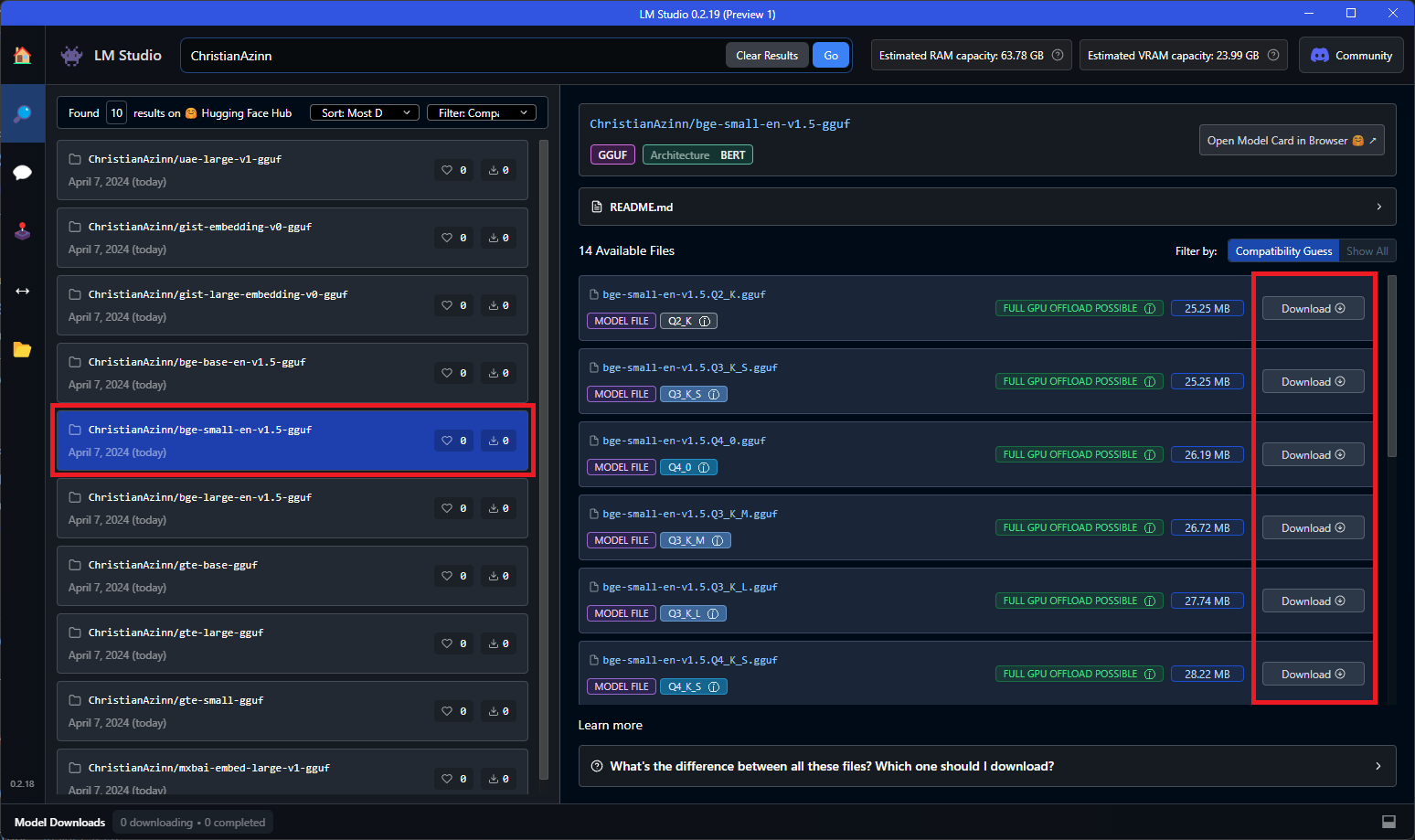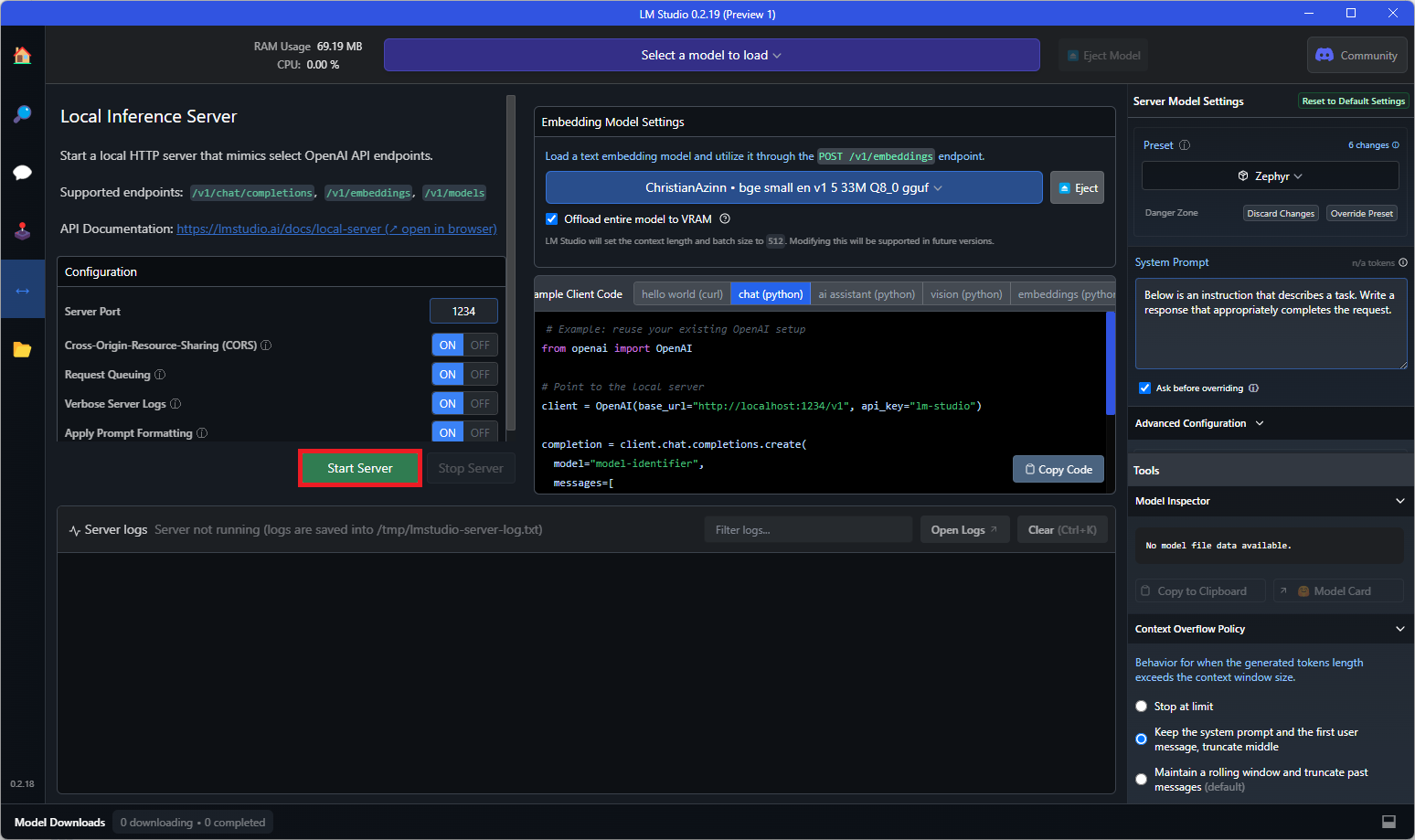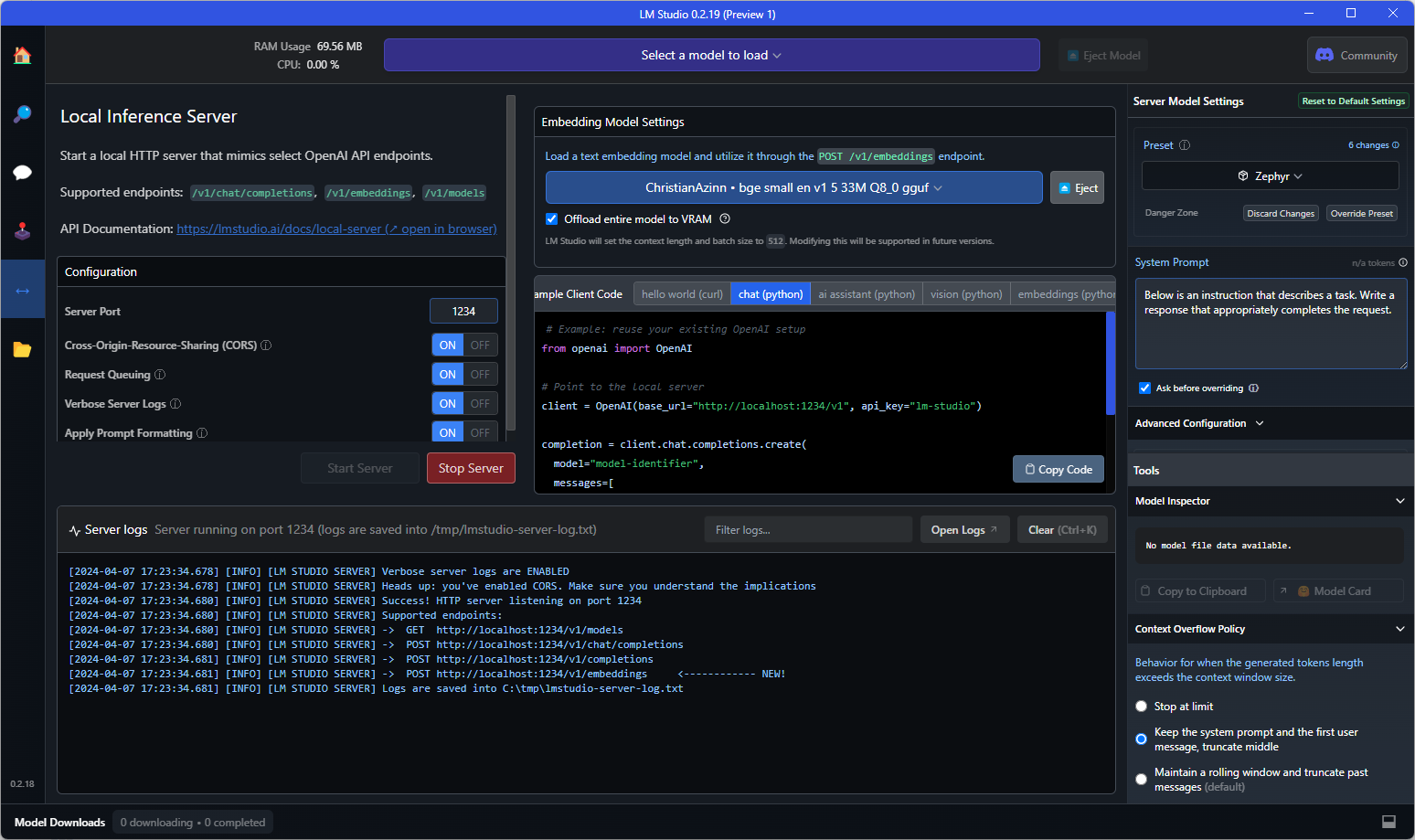File size: 9,824 Bytes
7092481 f9fa547 7092481 |
1 2 3 4 5 6 7 8 9 10 11 12 13 14 15 16 17 18 19 20 21 22 23 24 25 26 27 28 29 30 31 32 33 34 35 36 37 38 39 40 41 42 43 44 45 46 47 48 49 50 51 52 53 54 55 56 57 58 59 60 61 62 63 64 65 66 67 68 69 70 71 72 73 74 75 76 77 78 79 80 81 82 83 84 85 86 87 88 89 90 91 92 93 94 95 96 97 98 99 100 101 102 103 104 105 106 107 108 109 110 111 112 113 114 115 116 117 118 119 120 121 122 123 124 125 126 127 128 129 130 131 132 133 134 135 136 137 138 139 140 141 142 143 144 145 146 147 148 149 150 151 152 153 |
---
base_model: thenlper/gte-large
inference: false
language:
- en
license: mit
model_creator: thenlper
model_name: gte-large
model_type: bert
quantized_by: ChristianAzinn
library_name: sentence-transformers
pipeline_tag: feature-extraction
tags:
- mteb
- bert
- gguf
- sentence-similarity
- sentence-transformers
- Sentence Transformers
---
# gte-large-gguf
Model creator: [thenlper](https://huggingface.co/thenlper)
Original model: [gte-large](https://huggingface.co/thenlper/gte-large)
## Original Description
General Text Embeddings (GTE) model. [Towards General Text Embeddings with Multi-stage Contrastive Learning](https://arxiv.org/abs/2308.03281)
The GTE models are trained by Alibaba DAMO Academy. They are mainly based on the BERT framework and currently offer three different sizes of models, including [GTE-large](https://huggingface.co/thenlper/gte-large), [GTE-base](https://huggingface.co/thenlper/gte-base), and [GTE-small](https://huggingface.co/thenlper/gte-small). The GTE models are trained on a large-scale corpus of relevance text pairs, covering a wide range of domains and scenarios. This enables the GTE models to be applied to various downstream tasks of text embeddings, including **information retrieval**, **semantic textual similarity**, **text reranking**, etc.
## Description
This repo contains GGUF format files for the gte-large embedding model.
These files were converted and quantized with llama.cpp [PR 5500](https://github.com/ggerganov/llama.cpp/pull/5500), commit [34aa045de](https://github.com/ggerganov/llama.cpp/pull/5500/commits/34aa045de44271ff7ad42858c75739303b8dc6eb), on a consumer RTX 4090.
This model supports up to 512 tokens of context.
## Compatibility
These files are compatible with [llama.cpp](https://github.com/ggerganov/llama.cpp) as of commit [4524290e8](https://github.com/ggerganov/llama.cpp/commit/4524290e87b8e107cc2b56e1251751546f4b9051), as well as [LM Studio](https://lmstudio.ai/) as of version 0.2.19.
# Meta-information
## Explanation of quantisation methods
<details>
<summary>Click to see details</summary>
The methods available are:
* GGML_TYPE_Q2_K - "type-1" 2-bit quantization in super-blocks containing 16 blocks, each block having 16 weight. Block scales and mins are quantized with 4 bits. This ends up effectively using 2.5625 bits per weight (bpw)
* GGML_TYPE_Q3_K - "type-0" 3-bit quantization in super-blocks containing 16 blocks, each block having 16 weights. Scales are quantized with 6 bits. This end up using 3.4375 bpw.
* GGML_TYPE_Q4_K - "type-1" 4-bit quantization in super-blocks containing 8 blocks, each block having 32 weights. Scales and mins are quantized with 6 bits. This ends up using 4.5 bpw.
* GGML_TYPE_Q5_K - "type-1" 5-bit quantization. Same super-block structure as GGML_TYPE_Q4_K resulting in 5.5 bpw
* GGML_TYPE_Q6_K - "type-0" 6-bit quantization. Super-blocks with 16 blocks, each block having 16 weights. Scales are quantized with 8 bits. This ends up using 6.5625 bpw
Refer to the Provided Files table below to see what files use which methods, and how.
</details>
## Provided Files
| Name | Quant method | Bits | Size | Max RAM required | Use case |
| ---- | ---- | ---- | ---- | ---- | ----- |
| Name | Quant method | Bits | Size | Use case |
| [gte-large.Q2_K.gguf](https://huggingface.co/ChristianAzinn/gte-large-gguf/blob/main/gte-large.Q2_K.gguf) | Q2_K | 2 | 144 MB | smallest, significant quality loss - not recommended for most purposes |
| [gte-large.Q3_K_S.gguf](https://huggingface.co/ChristianAzinn/gte-large-gguf/blob/main/gte-large.Q3_K_S.gguf) | Q3_K_S | 3 | 160 MB | very small, high quality loss |
| [gte-large.Q3_K_M.gguf](https://huggingface.co/ChristianAzinn/gte-large-gguf/blob/main/gte-large.Q3_K_M.gguf) | Q3_K_M | 3 | 181 mB | very small, high quality loss |
| [gte-large.Q3_K_L.gguf](https://huggingface.co/ChristianAzinn/gte-large-gguf/blob/main/gte-large.Q3_K_L.gguf) | Q3_K_L | 3 | 198 MB | small, substantial quality loss |
| [gte-large.Q4_0.gguf](https://huggingface.co/ChristianAzinn/gte-large-gguf/blob/main/gte-large.Q4_0.gguf) | Q4_0 | 4 | 200 MB | legacy; small, very high quality loss - prefer using Q3_K_M |
| [gte-large.Q4_K_S.gguf](https://huggingface.co/ChristianAzinn/gte-large-gguf/blob/main/gte-large.Q4_K_S.gguf) | Q4_K_S | 4 | 203 MB | small, greater quality loss |
| [gte-large.Q4_K_M.gguf](https://huggingface.co/ChristianAzinn/gte-large-gguf/blob/main/gte-large.Q4_K_M.gguf) | Q4_K_M | 4 | 216 MB | medium, balanced quality - recommended |
| [gte-large.Q5_0.gguf](https://huggingface.co/ChristianAzinn/gte-large-gguf/blob/main/gte-large.Q5_0.gguf) | Q5_0 | 5 | 237 MB | legacy; medium, balanced quality - prefer using Q4_K_M |
| [gte-large.Q5_K_S.gguf](https://huggingface.co/ChristianAzinn/gte-large-gguf/blob/main/gte-large.Q5_K_S.gguf) | Q5_K_S | 5 | 237 MB | large, low quality loss - recommended |
| [gte-large.Q5_K_M.gguf](https://huggingface.co/ChristianAzinn/gte-large-gguf/blob/main/gte-large.Q5_K_M.gguf) | Q5_K_M | 5 | 246 MB | large, very low quality loss - recommended |
| [gte-large.Q6_K.gguf](https://huggingface.co/ChristianAzinn/gte-large-gguf/blob/main/gte-large.Q6_K.gguf) | Q6_K | 6 | 278 MB | very large, extremely low quality loss |
| [gte-large.Q8_0.gguf](https://huggingface.co/ChristianAzinn/gte-large-gguf/blob/main/gte-large.Q8_0.gguf) | Q8_0 | 8 | 358 MB | very large, extremely low quality loss - recommended |
| [gte-large.Q8_0.gguf](https://huggingface.co/ChristianAzinn/gte-large-gguf/blob/main/gte-large_fp16.gguf) | FP16 | 16 | 670 MB | enormous, pretty much the original model - not recommended |
| [gte-large.Q8_0.gguf](https://huggingface.co/ChristianAzinn/gte-large-gguf/blob/main/gte-large_fp32.gguf) | FP32 | 32 | 1.34 GB | enormous, pretty much the original model - not recommended |
# Examples
## Example Usage with `llama.cpp`
To compute a single embedding, build llama.cpp and run:
```shell
./embedding -ngl 99 -m [filepath-to-gguf].gguf -p 'search_query: What is TSNE?'
```
You can also submit a batch of texts to embed, as long as the total number of tokens does not exceed the context length. Only the first three embeddings are shown by the `embedding` example.
`texts.txt`:
```
search_query: What is TSNE?
search_query: Who is Laurens Van der Maaten?
```
Compute multiple embeddings:
```shell
./embedding -ngl 99 -m [filepath-to-gguf].gguf -f texts.txt
```
## Example Usage with LM Studio
Download the 0.2.19 beta build from here: [Windows](https://releases.lmstudio.ai/windows/0.2.19/beta/LM-Studio-0.2.19-Setup-Preview-1.exe) [MacOS](https://releases.lmstudio.ai/mac/arm64/0.2.19/beta/LM-Studio-darwin-arm64-0.2.19-Preview-1.zip) [Linux](https://releases.lmstudio.ai/linux/0.2.19/beta/LM_Studio-0.2.19-Preview-1.AppImage)
Once installed, open the app. The home should look like this:

Search for either "ChristianAzinn" in the main search bar or go to the "Search" tab on the left menu and search the name there.

Select your model from those that appear (this example uses `bge-small-en-v1.5-gguf`) and select which quantization you want to download. Since this model is pretty small, I recommend Q8_0, if not f16/32. Generally, the lower you go in the list (or the bigger the number gets), the larger the file and the better the performance.

You will see a green checkmark and the word "Downloaded" once the model has successfully downloaded, which can take some time depending on your network speeds.

Once this model is finished downloading, navigate to the "Local Server" tab on the left menu and open the loader for text embedding models. This loader does not appear before version 0.2.19, so ensure you downloaded the correct version.

Select the model you just downloaded from the dropdown that appears to load it. You may need to play with configuratios in the right-side menu, such as GPU offload if it doesn't fit entirely into VRAM.

All that's left to do is to hit the "Start Server" button:

And if you see text like that shown below in the console, you're good to go! You can use this as a drop-in replacement for the OpenAI embeddings API in any application that requires it, or you can query the endpoint directly to test it out.

Example curl request to the API endpoint:
```shell
curl http://localhost:1234/v1/embeddings \
-H "Content-Type: application/json" \
-d '{
"input": "Your text string goes here",
"model": "model-identifier-here"
}'
```
For more information, see the LM Studio [text embedding documentation](https://lmstudio.ai/docs/text-embeddings).
## Acknowledgements
Thanks to the LM Studio team and everyone else working on open-source AI.
This README is inspired by that of [nomic-ai-embed-text-v1.5-gguf](https://huggingface.co/nomic-ai/nomic-embed-text-v1.5-gguf), another excellent embedding model, and those of the legendary [TheBloke](https://huggingface.co/TheBloke). |